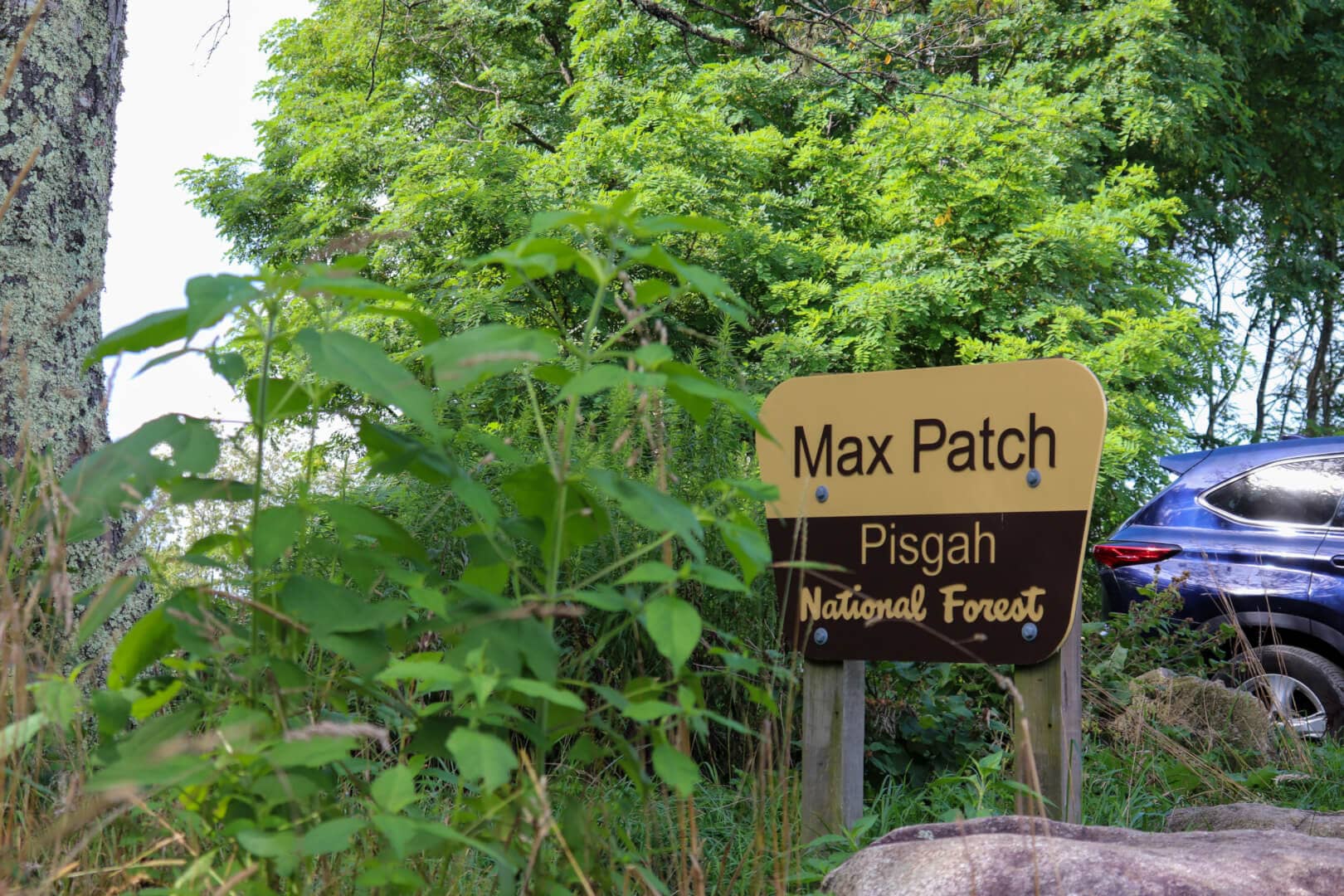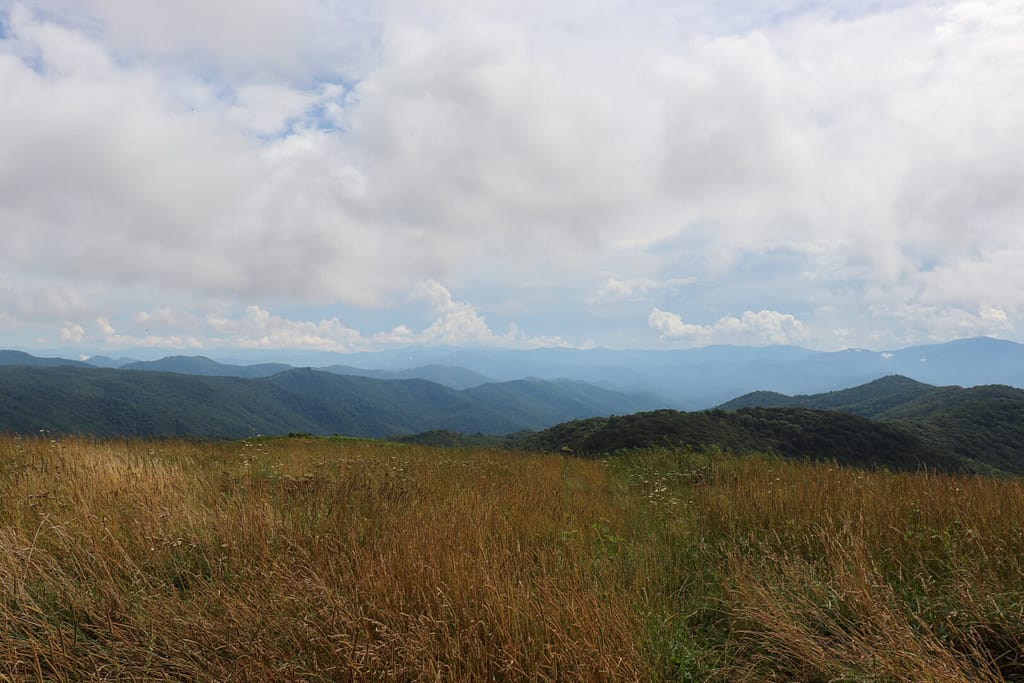Max Patch boasts unhindered views of the Blue Ridge Mountains in every direction from atop its grassy summit.
Max Patch reminds me of the iconic opening scene from the movie “The Sound of Music.” Although the mountains of North Carolina are small in contrast to the German Alps where that scene was filmed, it’s still a surreal experience to frolic across the crest of Max Patch Mountain. Keep reading to learn more about Max Patch and tips for your visit.

What is Max Patch?
Although the true history behind Max Patch, including its name, are still debated, most believe this to be a man-made grassy bald. Meaning, this mountain summit is naturally covered in forest like its neighboring mountaintops. But in the 1800s, farmers cleared this particular mountain for the use of their cattle. Over the years it has seen new growth, only to be cleared yet again so that the beautiful views can be enjoyed by all. Today it is managed by the North Carolina National Forest Service as it is part of the Pisgah National Forest.

Areas that are not trails are protected for the sake of wildlife. Even though it’s a grassy bald, there’s still only select trails to use and enjoy. Everything else is allowed to grow wild and be home to insects, birds, snakes, and more.
When to Visit Max Patch
Max Patch is often visited in the fall for distant views of fall foliage. And again, in the spring for all the wildflowers that cover its slopes. We visited in late summer, and I also recommend this time of the year. Being 4,629 feet in elevation on a grassy bald means the temperature is lower and the wind blows strongly keeping it cool. Some people choose to visit in winter too, but keep in mind that there’s often ice and sometimes snow here. The drive up to Max Patch is a long and rough gravel road that is not ideal for driving in the winter.



The Trails at Max Patch
Max Patch is well-known for intersecting with the Appalachian Trail. In fact, the main trail over the mountain is actually part of the Appalachian Trail. But the most common hike used to enjoy Max Patch starts in the small parking lot at the bottom of the peak. There’s a mile and a half long loop that will take you up one side, across, and down the other side before meeting back at the parking lot.



I recommend starting your hike to the left at the trailhead. This is an easier ascent to the top. Then you can continue down the other end where there are steps and a lengthier hike back. The left side has no steps so if you really want to make it easy, just go up the left side and back down the way you came. The elevation difference is only a few hundred feet making this hike easier than scaling the entire mountain height.

Tips for Your Visit
First and foremost, please stay on the trail. This is to be respectful of wildlife and ensure we will have this place to enjoy for years to come. Note that the trail is wooded on both ends of the loop before you reach the top. At the top of Max Patch there are other trails to explore. Be sure to do this when you visit so you can really take in all the sights.

When we went, late summer, there were lots of insects and birds chasing them. Gnats were very commonplace so keep this in mind if you’re planning a picnic up here. Which, I’ve read that this is a great picnic destination.
There are a couple different ways to get to Max Patch, but ultimately the roads are all narrow, windy, and rough. Most vehicles can make it through but if it’s rained recently, the water flowing down the road will make it more difficult to drive up. Here is the exact location of Max Patch.

Being Good Stewards of the Land
Efforts are made to create lasting habitats for the wildlife that call this mountain home. Over the years camping on top of Max Patch was allowed. But sadly this became too popular and the habitats were threatened. As it stands now, camping is no longer allowed at Max Patch. However, we all hope this is a temporary situation. The Forest Service has stated that they plan to prohibit camping for only two years. We’re one year down now. Year two concludes in July 2023.



But this is just a hope. Because the possibility of allowing camping here once again falls on our response. Those of us who choose to go out and enjoy these trails must also choose to be mindful of the homes we are visiting. Plants and animals alike reside in these places so we must be good stewards and not hinder their livelihood. If we all choose to do this, camping will be allowed again. But if some of us choose to ignore and be disrespectful to the habitats, then we will never be allowed to camp here again. Remember the responsibility you carry every time you step out on a hike. Together we can choose to be respectful and keep the outdoors alive and well for all to enjoy.

Closing Thoughts
I can’t wait to visit Max Patch again in other seasons to see how much it changes. When I do I’ll be sure to share that with you as well. Until then, let me know in the comments below if you visit and what you think. I’d love to hear from you!
Don’t forget to watch the final video in the “Road Tripping North Carolina” series. If you missed any of the previous posts and videos of this series, they are linked below so check them out. Until next time, enjoy exploring Chatt!

The Rest of the “Road Tripping North Carolina” Series:
- Part 1 –The Blue Ridge Parkway
- Part 2 –Hiking Waterrock Knob
- Part 3 –Camping in the Smokies and Clingman’s Dome
- Part 4 –Camping and Exploring Mount Mitchell
